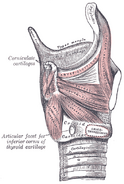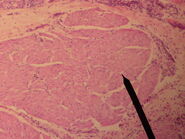Assessment |
Biopsychology |
Comparative |
Cognitive |
Developmental |
Language |
Individual differences |
Personality |
Philosophy |
Social |
Methods |
Statistics |
Clinical |
Educational |
Industrial |
Professional items |
World psychology |
Biological: Behavioural genetics · Evolutionary psychology · Neuroanatomy · Neurochemistry · Neuroendocrinology · Neuroscience · Psychoneuroimmunology · Physiological Psychology · Psychopharmacology (Index, Outline)
| Thyroarytenoid muscle | ||
|---|---|---|
| Muscles of the larynx, seen from above. | ||
| Latin | musculus thyroarytenoideus | |
| Gray's | subject #236 1083 | |
| Origin: | Inner surface of the thyroid cartilage (anterior aspect) | |
| Insertion: | Anterior surface of arytenoid cartilage | |
| Blood: | ||
| Nerve: | recurrent laryngeal branch of the vagus | |
| Action: | helps to adduct the vocal folds during speech | |
| Dorlands/Elsevier | m_22/12551138 | |
The Thyroarytenoid is a broad, thin, muscle which lies parallel with and lateral to the vocal fold, and supports the wall of the ventricle and its appendix.
Origin and insertion[]
It arises in front from the lower half of the angle of the thyroid cartilage, and from the middle cricothyroid ligament.
Its fibers pass backward and lateralward, to be inserted into the base and anterior surface of the arytenoid cartilage.
Parts of thyroarytenoid[]
The lower and deeper fibers of the muscle can be differentiated as a triangular band which is inserted into the vocal process of the arytenoid cartilage, and into the adjacent portion of its anterior surface; it is termed the Vocalis, and lies parallel with the vocal ligament, to which it is adherent.[1]
A considerable number of the fibers of the Thyreoarytænoideus are prolonged into the aryepiglottic fold, where some of them become lost, while others are continued to the margin of the epiglottis. They have received a distinctive name, Thyreoepiglotticus or Thyroepiglottic, and are sometimes described as a separate muscle. [2]
A few fibers extend along the wall of the ventricle from the lateral wall of the arytenoid cartilage to the side of the epiglottis and constitute the Ventricularis muscle.
Actions[]
The Thyreoarytœnoidei, consisting of two parts having different attachments and different directions, are rather complicated as regards their action.
Their main use is to draw the arytenoid cartilages forward toward the thyroid, and thus relax and shorten the vocal folds.
But, owing to the connection of the deeper portion with the vocal fold, this part, if acting separately, is supposed to modify its elasticity and tension, while the lateral portion rotates the arytenoid cartilage inward, and thus narrows the rima glottidis by bringing the two vocal folds together.
Additional images[]
References[]
External links[]
This article was originally based on an entry from a public domain edition of Gray's Anatomy. As such, some of the information contained herein may be outdated. Please edit the article if this is the case, and feel free to remove this notice when it is no longer relevant.
scalp/eyelid: occipitofrontalis (occipitalis, frontalis) - orbicularis oculi - corrugator supercilii - depressor supercilii
extraocular: levator palpebrae superioris - superior tarsal - rectus (superior, inferior, medial, lateral) - oblique (superior, inferior) - intraocular: ciliary - iris dilator - iris sphincter
ear: auriculares - temporoparietalis - stapedius - tensor tympani
nose: procerus - nasalis (dilatator naris) - depressor septi nasi - levator labii superioris alaeque nasi
mouth: levator anguli oris/depressor anguli oris - levator labii superioris/depressor labii inferioris - zygomaticus (major, minor) - mentalis - buccinator - orbicularis oris - risorius
mastication: masseter - temporalis - pterygoid (lateral, medial)
tongue: extrinsic (genioglossus - hyoglossus - chondroglossus - styloglossus) intrinsic (superior longitudinal - inferior longitudinal - transversus - verticalis)
soft palate: levator veli palatini - tensor veli palatini - musculus uvulae - palatoglossus - palatopharyngeus
pharynx: pharyngeal constrictor (inferior, middle, superior) - stylopharyngeus - salpingopharyngeus
larynx: cricothyroid - posterior cricoarytenoid - lateral cricoarytenoid - arytenoid - thyroarytenoid
- hu:Musculus thyreoarytenoideus
| This page uses Creative Commons Licensed content from Wikipedia (view authors). |



